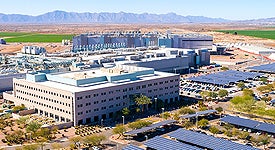The limits in the table below are specific numerical discharge limits established to meet the Industrial Pretreatment Program (IPP) objectives listed above. No person or Industrial User (IU) shall discharge or cause the discharge of wastewater or any pollutant into the Public Owned Treatment Works (POTW) that exceeds these local limits. These discharge limits are based upon either flow-proportional or time-proportional composite samples or grab samples where the collection of composites sampling is not possible or impractical. The local discharge limits apply at the point where the wastewater is discharged to the POTW. All concentrations or mass-based units are for the total pollutant.
| Pollutant of Concern | Local Discharge Limits |
|---|---|
| Arsenic (Total) | 0.22 mg/L |
| Boron (Total) | 2.40 mg/L |
| Cadmium (Total) | 0.06 mg/L |
| Chloroform | 0.37 mg/L |
| Chromium (Total) | 0.43 mg/L |
| Copper (Total) | 1.50 mg/L |
| Cyanide (Total) | 0.36 mg/L |
| Lead (Total) | 0.46 mg/L |
| Manganese (Total) | 1.00 mg/L |
| Mercury (Total) | 0.02 mg/L |
| Molybdenum (Total) | 0.074 mg/L |
| Nickel (Total) | 0.60 mg/L |
| Selenium (Total) | 0.07 mg/L |
| Silver (Total) | 0.30 mg/L |
| Zinc (Total) | 9.0 mg/L |
| Oil & Grease (HEM) | 100.0 mg/L |
| Fluoride | 10.0 mg/L |
The following limits are established to assist in establishing individual mass based limits in Industrial User Permits. These limits, when incorporated into an Industrial User Permit are determined existing pollutant loading and future additional pollutant loading from residential and non-residential sources.
| Pollutant of Concern | Permit Trigger Levels |
|---|---|
| Biochemical Oxygen Demand (BOD) | 63.0 lbs/day |
| Total Suspended Solids (TSS) | 73.0 lbs/day |



